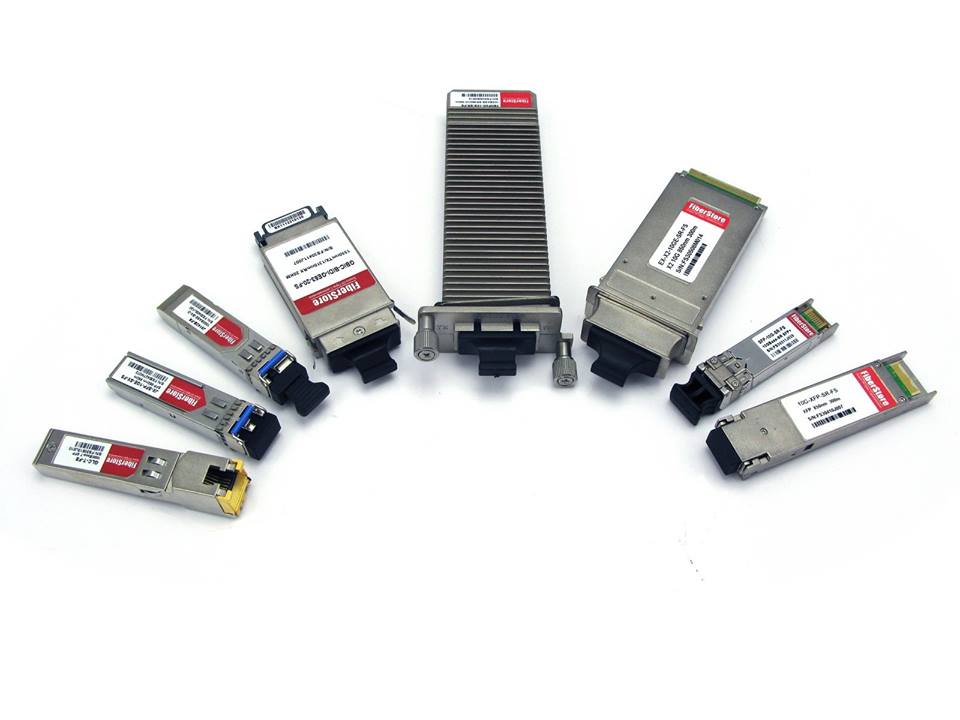Fiber Optics Solutions
ponedjeljak, 26.01.2015.
FAQ about Gigabit Ethernet Transceiver Modules part 2
In the last paper we discuss the "FAQ we need to know about Gigabit Ethernet Transceiver Modules", and in this paper we are going to talk atout 10Gigabit Ethernet fiber optic transceiver.
Q:What are the main types of Transceiver Module?
A:Transceiver modules are available in various form factors, and can be optical (fibre optic) or designed for copper wiring. Different transceiver modules support different data rates, from 100Base (100 Mbit/s) up to 100GbE (100 Gbit/s). There are some common types of transceiver modules as the following:
- Gigabit interface converter (GBIC) : 1 Gigabit Ethernet

- XENPAK : 10 Gigabit Ethernet
- X2 : 10 Gigabit Ethernet
- Small form-factor pluggable (SFP) : 1 Gigabit Ethernet, also known as the Mini-GBIC
- Small form-factor pluggable (SFP+) : 10 Gigabit Small Form Factor Pluggable
- XFP : 10 Gigabit Small Form Factor Pluggable (slightly larger than the SFP+)
- Quad Small Form-factor Pluggable Plus (QSFP+) : 40 Gigabit Ethernet
- C Form-Factor Pluggable (CFP) : 40 – 100 Gigabit Ethernet
Q:What tools do I need when installing a Transceiver Module?
A:The following is a list of the tools which are recommended when installing a Transceiver module:
- A Wrist strap or similar personal grounding device designed to stop ESD occurrences.
- An Antistatic mat or similar which the transceiver can be placed on.
- Fibre-optic end-face cleaning tools and inspection equipment.
- A flat head screw driver is require to install a XENPAK transceiver module.
Q:What are CWDM and DWDM Transceiver Modules?
A:Wavelength-division multiplexing (WDM) is a technology which multiplexes a number of optical carrier signals onto a single optical fiber by using different wavelengths (i.e., colors) of laser light. WDM is divided into different wavelength patterns, conventional/coarse wavelength-division multiplexing (CWDM) and dense wavelength-division multiplexing (DWDM). In general, a CWDM (coarse WDM) MUX/DEMUX deals with small numbers of wavelengths, typically eight, but with large spans between wavelengths (spaced typically at around 20nm). A DWDM (dense WDM) MUX/DEMUX deals with narrower wavelength spans (as small as 0.8nm, 0.4nm or even 0.2nm), and can accommodate 40, 80, or even 160 wavelengths. CWDM and DWDM transceiver modules are the transceiver modules which are combined the CWDM or DWDM technology. The main advantage of both CWDM and DWDM is that they allow you to expand your networks capacity without the need for physical fibre optic cabling. Click and see 1GB DWDM transceiver price.
Q:What is DOM support?
A:DOM, short for Digital optical monitoring, is a feature which allows you to monitor many parameters of the transceiver module in real-time. DOM allows you to monitor the TX (transmit) and RX (receive) of the module, as well as input/output power, temperature, and voltage. Network administrators can then check and ensure that the module is functioning correctly.
Q:What is a ‘Rugged’ (RGD) Transceiver Module?
A:You may be interested in the “-RGD” in the product number of some transceiver module. In fact, these are enhanced transceiver modules which have been designed for greater durability, and can operate under more extreme conditions. Rugged transceivers may feature enhanced ESD protection, and extended operating temperature range.
Q:What are the main types of 10 Gigabit Ethernet SFP+ Modules?
A:10 Gigabit Ethernet is 10 times faster than gigabit Ethernet, with a data rate of 10 Gbit/s which is defined by the IEEE 802.3ae-2002 standard. The following list shows us fibre SFP module 10G types.
- 10GBASE-SR SFP
Medium: Multi-mode fibre (MMF)
Distance: up to 300 metres
Wavelength: 850 nm - 10GBASE-LR SFP
Medium: Single-mode fibre (SMF)
Distance: up to 10 km
Wavelength: 1310 nm - 10GBASE-LRM SFP
Medium: Multi-mode fibre (MMF)
Distance: up to 220 metres
Wavelength: 1310 nm - 10GBASE-ER SFP
Medium: Single-mode fibre (SMF)
Distance: up to 40 km
Wavelength: 1550 nm - 10GBASE-ZR SFP
Medium: Single-mode fibre (SMF)
Distance: up to 80 km
Wavelength: 1550 nm - 10GBASE-LX4 SFP
Medium: Multi-mode fibre (MMF)
Distance: up to 300 metres
Medium: Single-mode fibre (SMF)
Distance: up to 10 km
Wavelength: 1300 nm - 10GBASE-CX4 SFP
Medium: Copper
Distance: up to 15 metres
Q:How about Fiberstore Transceiver Modules?
A:Fiberstore provides a full set of comaptible fiber optic transceiver module solution cover all the famous brands, such as Cisco, HP, Finisar and so on, which can satisfy you with a full range of services. We guarantee the compatibility of all of our transceiver modules, and always ensure that they meet or surpass the standards set by the manufacturers of the devices in which they are intended for use.
Finisar, especially, you can find a full product line of our Cisco SFP with a good price and enjoy same-day shipping, such as GLC-FE-100LX, GLC-FE-100LX-RGD, GLC-LX-SM-RGD and Cisco compatible copper SFP, etc. According to your requirements, we welcome any inquiry for customized fiber optical transceiver. In addition, a variety of fiber patch cables are also offered with a good price and high quality. Fiberstore will give you a pefect solution for your network transmission.
Article Source: Transceiver Modules FAQ Pool
| < | siječanj, 2015 | > | ||||
| P | U | S | Č | P | S | N |
| 1 | 2 | 3 | 4 | |||
| 5 | 6 | 7 | 8 | 9 | 10 | 11 |
| 12 | 13 | 14 | 15 | 16 | 17 | 18 |
| 19 | 20 | 21 | 22 | 23 | 24 | 25 |
| 26 | 27 | 28 | 29 | 30 | 31 | |
Srpanj 2015 (1)
Lipanj 2015 (4)
Svibanj 2015 (3)
Travanj 2015 (13)
Ožujak 2015 (10)
Veljača 2015 (8)
Siječanj 2015 (9)
Prosinac 2014 (4)
Dnevnik.hr
Gol.hr
Zadovoljna.hr
Novaplus.hr
NovaTV.hr
DomaTV.hr
Mojamini.tv
About Me
Ima Blogger, Just Share Various Fiber Optic Telecom Network Topics, Information, News, Questions, Sources and Network Solutions.
